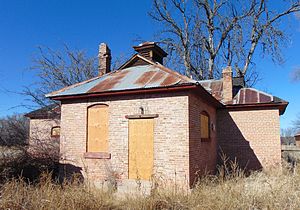Little Boquillas Ranch

The Little Boquillas Ranch House.
|
|
| Industry | Cattle ranching |
|---|---|
| Founded | 1901 |
| Headquarters | Fairbank, Arizona, USA |
| Parent | Kern County Land and Cattle Company |
The Little Boquillas Ranch is an historic ranch property located in western Cochise County, Arizona, near the Fairbank Historic Townsite in what is now part of the San Pedro Riparian National Conservation Area.
The Little Boquillas Ranch gets its name from the San Juan de las Boquillas y Nogales (Saint John of the Little Springs and Walnut Trees) land grant, which was granted to the family of Rafael Elias Gonzales by the Mexican government in 1833. The grant ran from a point near what is now the ghost town of Charleston, Arizona, north to a point just to the south of Fairbank, along the San Pedro River. The San Rafael del Valle grant, owned by Rafael's cousin, Captain Ignacio Elias Gonzales, was immediately to the south of the Boquillas grant and ran from what is now the community of Hereford north to Charleston. Both were roughly four "sitios", or approximately 18,000 acres, in size.
The early years were prosperous for the Mexican settlers, but they didn't last for long. The local Apaches soon started raiding again, leading to the abandonment of the area for the next few decades. By the late 1840s, the only remnant of the Mexican settlement were thousands of wild cattle left behind to roam freely on the open range. Following the end of the Mexican-American War (1846-1848) and the Gadsden Purchase in 1853, most of the San Pedro Valley became part of the United States, which agreed to acknowledge and respect the legitimacy of the old Spanish and Mexican land gants in the 1848 Treaty of Guadalupe Hidalgo. Apache raids continued, postponing the development of the area until the final quarter of the century, when silver and copper were discovered in the Tombstone and Bisbee areas, leading to a rush of incoming American settlers. Being the only land with a reliable source of water for miles around, the old Mexican land grants along the San Pedro River quickly filled up with American homesteaders and other settlers, many of whom made a living producing food and other necessities for the people in the nearby boomtowns and the soldiers at Fort Huachuca.
...
Wikipedia
